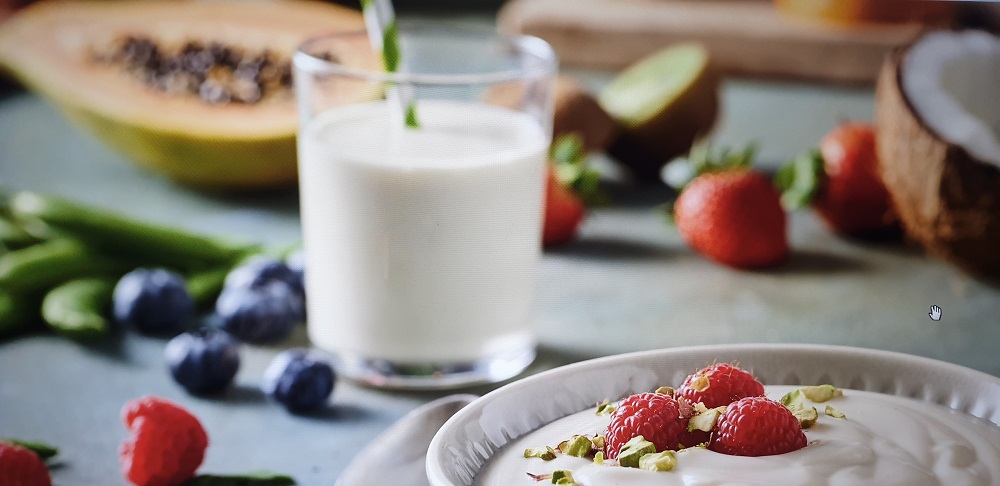CHR. HANSEN, one of the world's largest suppliers of solutions in cultures and enzymes for the food industry and microbial solutions for the human health, plant health and animal health sectors, is reshaping the market for fermented plant-based products with its new Vega™ culture solutions.
Designed to simplify culture selection while ensuring robust performance across different plant bases and blends, the Vega™ Culture Kit consists of customisable starter cultures, probiotics and bioprotective strains that manufacturers can combine to create plant-based products. It provides manufacturers with the tools and flexibility to differentiate their products in the market by tailoring the taste, texture and health benefits and extending freshness and shelf life.
The robust starter range offers choices for selecting the type of taste and texture – from mild and relatively simple in composition in Vega™ Mild, Vega™ Classic and Vega™ Premium to more complex with more acidity in Vega™ Vibe and Vega™ Harmony. An additional range of flavour adjuncts is available to also tailor taste to specific plant bases. These starter cultures can likewise produce regular to high texture and creamy mouthfeel.

Chr. Hansen's survey of fermented plant-based categories show that vegurts (Chr. Hansen's coined name for the plant-based yogurt category) is the largest segment with more than 66% of products.
To deliver health benefits and ensure high and stable probiotic cell counts throughout a product's shelf life, the Vega™ Culture Kit includes Vega™ nu-trish®, a range of cultures that includes the world's most researched probiotics. Vega™ nu-trish® BY-101 is a balanced blend of classic starter culture and Bifidobacterium, BB-12 while Vega™ nu-trish® GY-101 blends the classic starter culture with Lactobacillus rhamnosus, LGG.
“Chr. Hansen has the world's best documented probiotics, particularly with BB-12® and LGG®. We have been looking to incorporate those into plant-based products in a culture that makes it simple to use yet the cell count throughout the shelf life is at the level that provides the anticipated health benefit,” said Ross Crittenden, senior director of plant-based cultures at Chr. Hansen.
For sustainability and quality, the Vega™ Culture Kit includes Vega™ FreshQ®, a culture that keeps products fresher for longer. The Vega™ FreshQ® 101 delays spoilage growth by yeasts and moulds due to its specific competitive fermentation action.
“The idea of the culture kit is that manufactures can mix and match the various cultures. So if they want a particular type of taste or texture but also want probiotics in that culture and have a problem with yeast and moulds and need to improve the sustainability and reduce wastage, they can combine various cultures depending on their requirements and create the culture that will work in the target product,” said Crittenden.

Ross Crittenden, senior director of plant-based cultures at Chr. Hansen
The Vega™ Culture Kit works with different plant bases – from soy, pea, oat, coconut and nuts – and blends. Expertly selected and blended for superior performance in plant bases, the cultures are dairy-free and non-GMO and meet Kosher and Halal requirements. The products have good fermentation times and low post-acidification, particularly with the mild cultures.
Plant-based alternatives growing roots
The growing trend for a healthier, more sustainable lifestyle in recent years is fueling shifts in how people perceive, select and consume food. As the pandemic magnifies the need for health-boosting food and people focus on achieving wellness, flexitarianism is expected to rise even further. More consumers are expected to turn to plant-based diets and reduce their intake of meat, if not eliminate it altogether, for health, diet and even environmental reasons.
Consumers cutting down on animal-based products but not strictly following a vegan or vegetarian diet, most of them Gen Zs, now account for 42% of global consumers, according to Euromonitor's Health and Nutrition Survey fielded last year. Vegans and vegatarians represent 4% and 6% of global consumers, respectively. As acceptance of plant-based options continues to rise, food manufacturers are starting to diversify their product portfolios and build up their selection of plant-based alternatives. In regions such as Asia, plant-based products such as milks are nothing new, according to Crittenden.
“Asia has a long history of use of soya milk and other plant-based products. In Western markets, there has been, over the past decade in particular, a consumer swing toward more flexitarian diets. People want to consume more plant-based proteins and fats in their diets and less of the traditional animal-based products,” Crittenden added.
In the US dairy industry, he shared, plant-based milks now account for more than 10% of consumed milk products, followed by other dairy alternative categories such as yogurt and cheese. Besides gaining more traction each year, plant-based alternatives are becoming more diverse.
Chr. Hansen's survey of the fermented plant-based categories show that vegurts (Chr. Hansen's coined name for the plant-based yogurt category) is the largest segment with more than 66% of products.
“We use the word vegurt to describe plant-based yogurts because plant-based alternative to dairy yogurt” is quite a sentence compared to having a single word for the category,” Crittenden shared.
Crittenden said the array of plant-based proteins used at present comprises a range of different grains, nuts, and legumes and pulses. Grain products that can be used include oats, quinoa, buckwheat, spelt, rice and millet. For nuts, there are coconut, macadamia, almond, hazelnut and cashew. Plant-based protein sources consist of soy, pea, lupine and fava.
Crittenden noted the continuous growth in the complexity of bases: “As consumers increasingly look for products with a good nutritional profile, some of the proteins sources like oats are blended with soy or coconut to provide a different mix, thereby broadening the range of bases that the cultures need to be able to ferment,” he added.
The plant bases used vary across regions. “In Asian markets where there's a long tradition of use of soy, soy still dominates. In Western markets, there has not been a lot of new launches using soy,” said Crittenden.
Coconut and oats are the dominant bases in Western regions. While soy-based yogurt continues to be strong in Europe because of some brands, new launches tend to be based on coconut or oats.
“We're seeing the emergence of pea protein because of the supply reliability and the good functionality. It can be blended with oat protein to further improve the functionality and the nutritional profile,” he noted.
Disrupting the market with Vega Culture Kit
Chr. Hansen has developed its Vega Culture Kit to address both manufacturer and consumer needs. For producers, the kit delivers robust and consistent fermentation, low post-acidification, stable cell counts, options to optimise culture to base or application, choice to differentiate, extended shelf life, and reduction in recipe complexity and costs.
“As for consumers, taste and texture top drivers, followed by health benefits, clean label and sustainability. Having been producing cultures since end-2017, we know how crucial it is for manufacturers to deliver the same kind of experience consumers are used to in order for the products to succeed,” Crittenden said. The Vega™ Culture kit meets consumers' taste, texture, health and sustainability requirements, he added.
As the complexity of the bases used increases, the focus turns to how the culture can handle the different materials to create the product with the desired profiles. “Fermentation plays a key role. What we have done – and continue to do – at Chr. Hansen is to look at developing cultures that can really handle the complexity of different plant bases that are used to produce products.,” Crittenden added.
With plant-based products, the challenge in developing new cultures lies in being able to ferment all cultures consistently and robustly. Because there are different plant bases with varying compositions, the fermentation outcomes are different. “It really becomes a case that every producer has a unique base composition or a unique recipe for their wide mass that needs to be fermented,” said Crittenden.
“Chr. Hansen's Vega™ Philosophy is about making life simple for manufacturers through superior cultures that deliver the performance and features appreciated by consumers of Vegurt,” he shared.
From its culture collection exceeding 40,000 different strains, the company selects those that are able to perform very well on a wide range of different plant bases and develops these cultures for their ability to ferment in plant bases. “These cultures will perform well in different plant bases no matter what recipe a producer puts together. This way, the culture kit caters to both manufacturer and consumer needs,” Crittenden noted.
Collaborating with manufacturers
Chr. Hansen works closely with customers through flexible partnerships. Chr. Hansen can develop bespoke custom cultures and also handles contract manufacture of proprietary cultures and can co-develop cultures, mixing a partner's cultures with Chr. Hansen strains to produce an optimum outcome.
“We use ecosystems to accelerate development,” said Crittenden, adding that Chr. Hansen is working with other players in other segments of the supply chain. The company is collaborating within Mista, an ecosystem of partners with global capabilities to address challenges in the food system. It is currently working with Ingredion, AAK and Givaudan, leveraging each company's expertise and best ingredients to co-develop a best-in-class plant-based yoghurt that features great taste and clean label, and is nutritious, sustainable and affordable.
Chr. Hansen continues to optimise the base composition, reduce the amount of stabiliser, cut costs and improve the clean label. Two of the biggest challenges it sees in ensuring quality plant-bases products, in particular as regards the taste, are the off notes coming from the plant bases themselves and producing the desired flavour. “There are still customers asking for plant-based product that taste like dairy,” Crittenden shared.
As in the dairy industry, there can be problems with yeast and moulds depending on the factory. “Our team really screens for efficacy using a whole bank of different cultures until we find the one that is able to work in the plant bases. The team can also do challenge tests in a customer's base against a whole bank of yeasts and moulds that we've been collecting from factories producing plant-based products,” said Crittenden.
Beyond the functionality and health benefits, Chr. Hansen's Vega™ Culture Kit enables savings for all stakeholders, Crittenden noted. The longer shelf life reduces food waste across the value chain. Manufacturers can cut batch frequency and production wastes yet increase savings in reallocation costs. For retailers, they can optimise logistics and sell more products ahead of expiration dates, which also leads to less wastage.
“As for consumers, they can enjoy higher-quality products without artificial preservatives and reap health benefits at much less cost,” Crittenden said.

 iConnectHub
iConnectHub
 Login/Register
Login/Register Supplier Login
Supplier Login



























